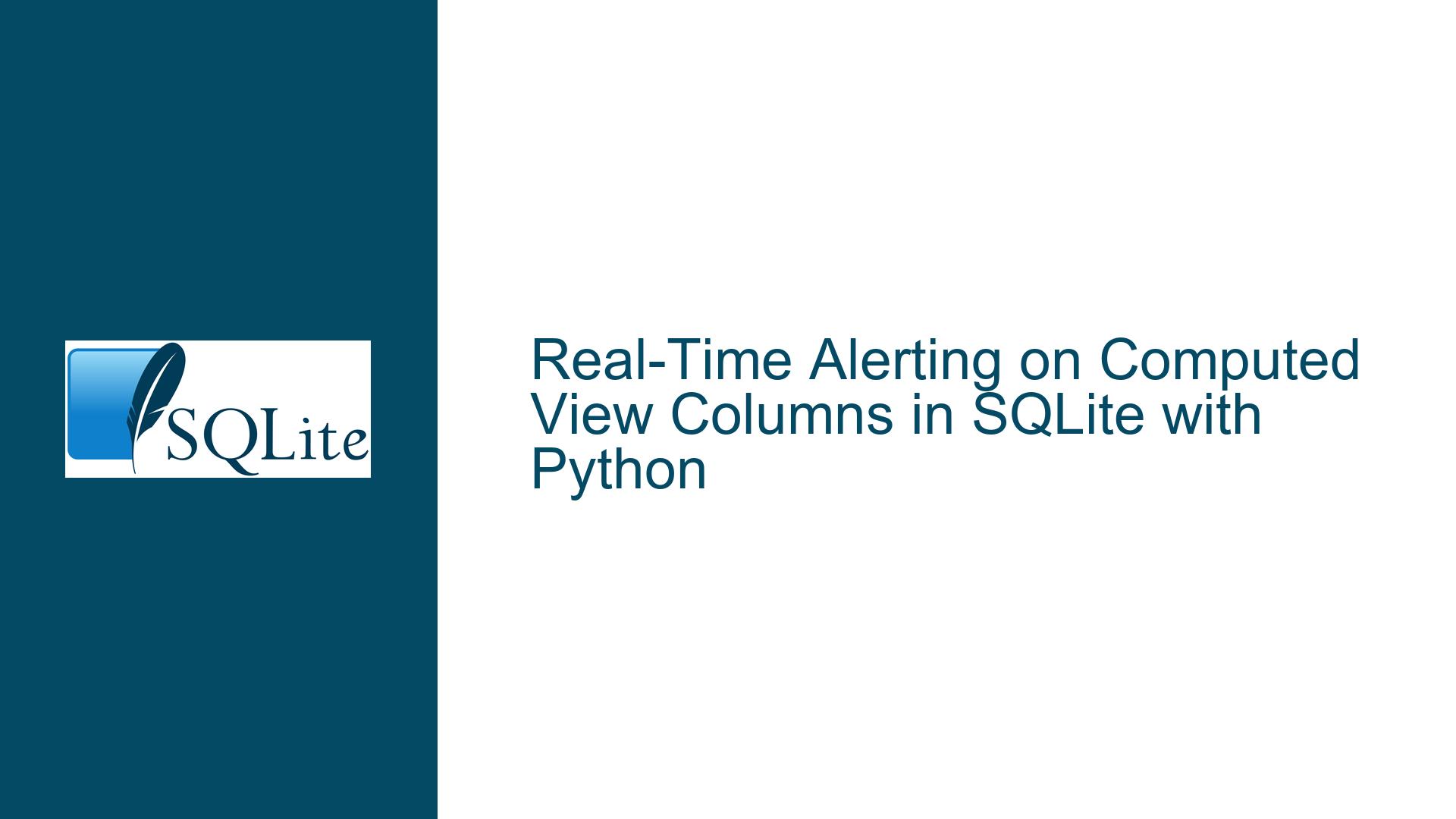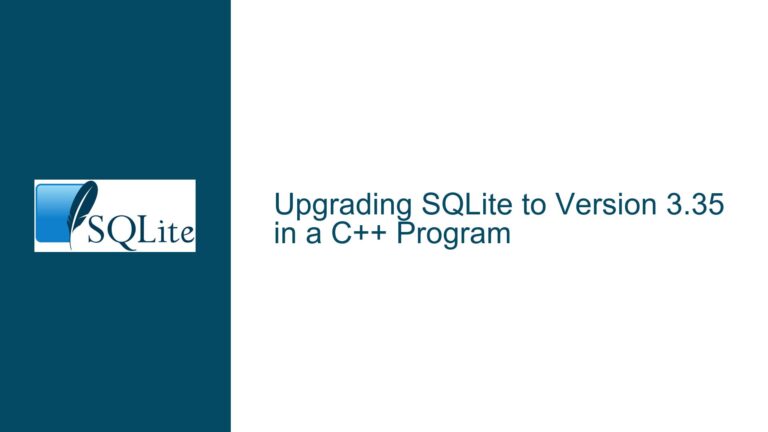Real-Time Alerting on Computed View Columns in SQLite with Python
Issue: Real-Time Detection of Threshold Breaches in Computed View Columns
The core challenge involves implementing a real-time alerting mechanism in a Python service that interacts with an SQLite database. The database schema includes a base table (data) and a view (data_view) that computes derived values. The data table stores sensor readings with columns id (sensor identifier), distance (a raw value between 0-100), and last_seen (timestamp of the last sensor update). The data_view view dynamically computes minutes_unseen (elapsed time since last_seen) and adjusts distance based on this value. The goal is to trigger alerts when the computed distance in data_view reaches 50 for any sensor, without relying on polling mechanisms that introduce latency or resource overhead.
Key Technical Constraints:
- Dynamic Computation: The
distancevalue indata_viewis not stored but computed on-the-fly usingminutes_unseen, which itself depends on the current time (now - last_seen). This means the value changes passively over time without explicit updates to the underlyingdatatable. - Concurrency Requirements: The Python service uses multiple threads—one for writing sensor data and others for reading. Thread safety and connection management are critical to avoid errors like "recursive cursor" exceptions.
- Real-Time Responsiveness: Traditional triggers fail because they rely on explicit data modifications, not passive value changes. Polling introduces latency and resource contention if not optimized.
Root Causes: Trigger Limitations, Passive Value Dynamics, and Threading Misconfigurations
1. Inapplicability of Triggers for Passive Value Monitoring
SQLite triggers execute in response to explicit data modification events (e.g., INSERT, UPDATE). Since minutes_unseen and distance are computed dynamically in data_view and not stored, no trigger fires when these values change. A trigger on the data table’s last_seen column would only activate when last_seen is updated, not as time elapses. For example:
CREATE TRIGGER after_data_update
AFTER UPDATE OF last_seen ON data
FOR EACH ROW
BEGIN
-- This only runs when last_seen is explicitly updated
SELECT alert_python(NEW.id);
END;
This trigger would miss threshold breaches occurring between updates to last_seen.
2. Time-Dependent Computations Require Active Polling
The computed distance value depends on the current time, which is not stored in the database. To detect threshold crossings, the application must actively recompute distance by querying data_view at intervals. The absence of a built-in event mechanism for time-based changes necessitates a polling strategy.
3. Thread Contention and Connection Misconfiguration
The Python service initially shares a single SQLite connection across multiple threads, configured with check_same_thread=False and isolation_level=None. While SQLite connections are thread-safe in serialized mode, sharing a single connection across threads leads to:
- Cursor Conflicts: Concurrent cursor usage from multiple threads causing "recursive cursor" errors.
- Transaction Collisions: Uncoordinated
BEGIN/COMMITstatements across threads, leading to incomplete transactions or lock contention. - WAL Mode Misunderstanding: Write-Ahead Logging (WAL) allows concurrent reads and writes, but connection-specific settings (e.g.,
journal_mode) must be consistent across threads.
Solutions: Optimized Polling, Thread-Safe Connections, and Query Tuning
1. Implementing Efficient Polling with Indexed Queries
Polling Query Design
Instead of querying the entire data_view, use a targeted query that leverages indexes on last_seen:
SELECT id
FROM data
WHERE last_seen < datetime('now', '-50 minutes')
ORDER BY last_seEN
LIMIT 1;
Optimization Steps:
- Index on
last_seen: Create an index to accelerate time-based filtering:CREATE INDEX idx_data_last_seen ON data(last_seen); - Parameterized Time Threshold: Compute the threshold time externally (e.g., in Python) to avoid recalculating
datetime('now')for each row:threshold_time = (datetime.now() - timedelta(minutes=50)).strftime('%Y-%m-%d %H:%M:%S') cursor.execute("SELECT id FROM data WHERE last_seen < ?", (threshold_time,)) - Polling Interval Tuning: Balance responsiveness and resource usage. A 5-second interval is often sufficient for near-real-time alerts without excessive CPU load.
Handling Alert Deduplication
To avoid repeated alerts for the same sensor, track alerted sensors in a Python set or a dedicated alerts table:
alerted_sensors = set()
while True:
cursor.execute("SELECT id FROM data WHERE last_seen < ?", (threshold_time,))
for row in cursor.fetchall():
sensor_id = row[0]
if sensor_id not in alerted_sensors:
send_alert(sensor_id)
alerted_sensors.add(sensor_id)
time.sleep(5)
2. Configuring Thread-Safe Database Connections
Connection Per Thread
Each thread (writer, reader, poller) should use a dedicated SQLite connection with consistent settings:
# Writer thread connection
writer_conn = sqlite3.connect('sensors.db', isolation_level=None)
writer_conn.execute('PRAGMA journal_mode=WAL;')
# Reader thread connection
reader_conn = sqlite3.connect('sensors.db', isolation_level=None)
reader_conn.execute('PRAGMA journal_mode=WAL;')
Critical Settings:
isolation_level=None: Disables autocommit, allowing explicit transaction control.PRAGMA journal_mode=WAL: Enables Write-Ahead Logging for concurrent access. Set once per database; subsequent connections inherit the mode.busy_timeout: Configures how long SQLite waits for locks before returningSQLITE_BUSY. Set to 5000ms (5 seconds) as a default:writer_conn.execute('PRAGMA busy_timeout=5000;')
Thread Lifecycle Management
Ensure connections are closed when threads terminate:
import threading
class PollerThread(threading.Thread):
def __init__(self):
super().__init__()
self.conn = sqlite3.connect('sensors.db', isolation_level=None)
self.running = True
def run(self):
while self.running:
# Polling logic
time.sleep(5)
def stop(self):
self.running = False
self.conn.close()
3. Hybrid Approach: Filesystem Notifications with Polling
Use OS-level filesystem events to trigger polls when the database changes, reducing unnecessary queries. In Python, use watchdog to monitor the database file:
from watchdog.observers import Observer
from watchdog.events import FileSystemEventHandler
class DBChangeHandler(FileSystemEventHandler):
def on_modified(self, event):
if event.src_path.endswith('sensors.db'):
run_polling_query()
observer = Observer()
observer.schedule(DBChangeHandler(), path='.', recursive=False)
observer.start()
Backup Polling: Combine with periodic polling (e.g., every 60 seconds) to handle cases where filesystem events are missed.
Conclusion
Real-time alerting on computed view columns in SQLite requires a multi-pronged approach: optimized polling queries with proper indexing, thread-safe connection management, and hybrid event-driven techniques. By avoiding shared connections, leveraging WAL mode, and tuning query performance, the Python service can achieve near-real-time responsiveness without excessive resource consumption.






